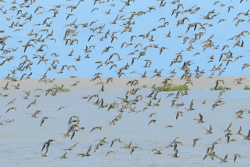|
|
Shorebird monitoringMany of the species that use the East Asian—Australasian Flyway (the Flyway) spend the majority of their year in Australia. Estimating the population size of migratory shorebirds while they are in Australia is important for their management. Population monitoring is an integral part of shorebird conservation and requires international coordination. Queensland shorebird species - Bird wetland indicator species and profiles Quick facts
Information on the numbers and distribution of migratory shorebirds in Queensland has been contributed by government funded studies, the establishment of the Australasian Wader Studies Group (AWSG) and majorly since 1992 by the Queensland Wader Study Group (QWSG), a special interest group of Birds Queensland (BQ). These, together with other interest groups, academic research records and surveys by Indigenous ranger programs contribute to shorebird population records and monitoring. Most information on monitoring of shorebirds comes from observations at high tide roost sites, where birds are easy to count, allowing for identification of individual species. In Australia, the best time to assess shorebird numbers are between December and February because migratory species are most settled in their non-breeding sites and are least likely to show fluctuation in numbers. Information is still incomplete for many parts of the coastline but work continues. View distribution of migratory shorebirds along the Queensland coast here. Monitoring shorebirdsPopulation estimates of shorebirds are largely based on data collected over many decades by volunteer bird enthusiasts working with various shorebird study groups. Given the legislative protection and high profile of migratory shorebirds, this citizen science effort is an especially valuable contribution to biodiversity conservation and wetland management. The Queensland Wader Study Group coordinates the collection of most population data within Queensland. The Australasian Wader Studies Group has a coordinating role throughout Australia and assists with intergovernmental efforts to conserve shorebirds throughout the Flyway. Australian and Flyway shorebird data are periodically reviewed and new population estimates made for Australia and the Flyway as a whole. Regular review is essential due to significant pressures being faced by migratory shorebirds and the declines in abundance of many species. Monitoring data is used to determine Waterbird Population Estimates (WPE) is an online database developed by Wetlands International with the support of Environment Canada and the Ramsar Convention. It allows access to regional shorebird and other waterbird population estimates and has archives of all previous estimates; hence there is an opportunity to consider long term trends in numbers throughout the Flyway. Australia's national shorebird population monitoring contributes to the WPE process and is run through the National Shorebird Monitoring program. It is used to inform best management practice to maintain shorebird populations and uses volunteers to survey about 150 key shorebird areas in order to detect national population trends. A revision of the East Asian-Australasian Flyway Population estimates for 37 listed migratory shorebird species have been published by the Australian Government in 2016, containing updated information on waterbird population estimates for migratory shorebirds. Additional linksLast updated: 25 January 2021 This page should be cited as: Department of Environment, Science and Innovation, Queensland (2021) Shorebird monitoring, WetlandInfo website, accessed 8 May 2025. Available at: https://wetlandinfo.des.qld.gov.au/wetlands/assessment/water-bird-research-assessment/shorebird-monitoring.html |

 — Department of the Environment, Tourism, Science and Innovation
— Department of the Environment, Tourism, Science and Innovation


